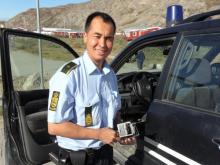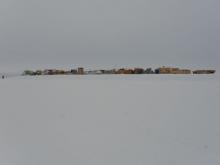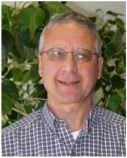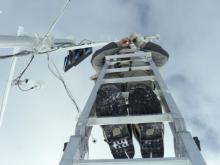Update
A PolarConnect live event from the field with Jim Pottinger and the team was held on Thursday, 19 August 2010. Access the archive!
What Are They Doing?
Solar radiation is the major energy source that drives our climate and supports life on earth. In this project, the research team gained a better understanding of the solar radiation reflected back into space and absorbed by our planet, also known as the Earth’s heat balance. The team collected data related to this balance using weather observing instruments and a specially equipped aircraft that could detect wind speed and directions and electromagnetic radiation.
The measurements were part of an international effort to record radiation called the Baseline Surface Radiation Network project. The data collected was used to further study the Greenland Ice Sheet and it’s processes, such as melting and gas exchange with the atmosphere.
Studying heat balance is an important concept in climatology because light surfaces, like snow, reflect more radiation back into space while dark surfaces, like water, absorb more radiation. When you have snow cover, about 90% of the solar energy that goes through the atmosphere is reflected back into space. But increasing the amount of water on the ice sheet causes less radiation to reflect and more heat to be absorbed. This increases the temperature and causes more ice to melt.
Where Are They?
The team lived and worked at Summit Station, located at the peak of the Greenland ice cap atop 3200 meters of ice. Summit is a scientific research station sponsored by the National Science Foundation that supports a diversity of scientific research, including year-round measurements of air-snow interactions that provide crucial knowledge for interpreting data from deep ice cores drilled both at Summit and elsewhere. During the summer months the camp is accessed via Kangerlussuaq, a small community located on the west coast of Greenland.
Latest Journals

Dr. Konrad Steffen is a professor of geography and the Director of the Cooperative Institute for Research in Environmental Sciences (CIRES) at the University of Colorado at Boulder. His research interests lie in the interactions between climate and snow and ice covered regions, in particular changes in ice sheets and sea level. Dr. Steffen has spent over thirty years conducting research in the arctic, much of which is in Greenland. To learn more about Dr. Steffen, please visit his faculty biography page (http://cires.colorado.edu/people/steffen/).

Nicolas (Nikko) Bayou is a PhD graduate student in Geography at the University of Colorado in Boulder. Mr. Bayou's bachelor's degree is in Science, and he has a masters degree in mechanical and aerospace engineering. His science and engineering experiences include modelling aircraft engines, analyzing flight/ground tests with Airbus, and serving as project lead for a business jet engines advance project. Mr. Bayou also co-designed the hull of the Italian team yacht for the America's Cup, an international boat race. Currently he is processing Greenland Climate Network (GC-Net) automatic weather station data in preparation for his thesis.





